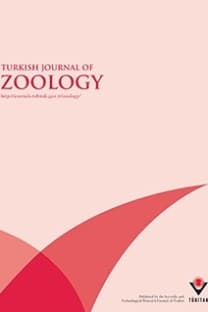Molecular systematics of the genus Pseudocerastes (Ophidia: Viperidae) based on the mitochondrial cytochrome b gene
Cytochrome b, genetic divergence, molecular systematics, Pseudocerastes, Viperidae, Iran
Molecular systematics of the genus Pseudocerastes (Ophidia: Viperidae) based on the mitochondrial cytochrome b gene
Cytochrome b, genetic divergence, molecular systematics, Pseudocerastes, Viperidae, Iran,
___
- Bostanchi H, Anderson SC, Kami HG, Papenfuss TJ (2006). A new species of Pseudocerastes with elaborate tail ornamentation from western Iran (Squamata: Viperidae). Proc Calif Acad Sci 4: 443– 450.
- Fathinia B, Anderson SC, Rastegar-Pouyani N, Jahani H, Mohamadi H (2009). Notes on the natural history of Pseudocerastes urarachnoides (Squamata: Viperidae). Russ J Herpetol 16: 134–138.
- Fathinia B, Rastegar-Pouyani N (2010). On the species of Pseudocerastes (Ophidia: Viperidae) in Iran. Russ J Herpetol 17: 275–279.
- Felsenstein J (1985). Confidence limits on phylogenies: an approach using the bootstrap. Evol 39: 783–791.
- Hall TA (1999). BioEdit: a user-friendly biological sequence alignment editor and analysis program for windows 95/98/NT. Nucleic Acids Symp Ser 41: 95–98.
- Latifi M (2000). Snakes of Iran. 3rd ed. Tehran, Iran: Department of the Environment Edition (in Farsi).
- Leviton AE, Anderson SC, Adler K, Minton SA (1992). Handbook to Middle East Amphibians and Reptiles. Oxford, OH, USA: SSAR.
- Librado P, Rozas J (2009). DnaSP v5: a software for comprehensive analysis of DNA polymorphism data. Bioinformatics 25: 1451– 1452.
- Phelps T (2010). Old World Vipers: A Natural History of the Azemiopinae and Viperinae. 1st ed. Frankfurt, Germany: Edition Chimaira.
- Saitou N, Nei M (1987). The neighbor-joining method: a new method for reconstructing phylogenetic trees. Mol Biol Evol 4: 406–425.
- Sambrook J, Fritsch EF, Maniatis T (1989). Molecular Cloning: A Laboratory Manual. 2nd ed. Cold Spring Harbor, NY, USA: Cold Spring Harbor Laboratory Press.
- Stümpel N, Joger U (2009). Recent advances in phylogeny and taxonomy of Near and Middle Eastern Vipers – an update. ZooKeys 31: 179–191.
- Swofford DL (2001). PAUP*. Phylogenetic Analysis Using Parsimony (*and Other Models), Version 4.0b10. Sunderland, MA, USA: Sinauer Associates.
- Tamura K, Stecher G, Peterson D, Filipsky A, Kumar S (2013). MEGA6: Molecular Evolutionary Genetics Analysis version 6.0. Mol Biol Evol 30: 2725–2729.
- Wüster W, Peppin L, Pook CE, Walker DE (2008). A nesting of vipers: phylogeny and historical biogeography of the Viperidae (Squamata: Serpentes). Mol Phyl Evol 49: 445–459.
- ISSN: 1300-0179
- Yayın Aralığı: 6
- Yayıncı: TÜBİTAK
Şule SÜLÜN, Sercan BAŞKURT, Özgür EMİROĞLU, Daniela GIANNETTO, Ali Serhan TARKAN
New record of a genus and species of Mymaridae (Hymenoptera: Chalcidoidea) from Iran
Zainab-alssadat BAYEGAN, Hosseinali LOTFALIZADEH, Mohammad-reza ZARGARAN, Rana POORAIIOUBY
A new species of the genus Dinotrema Foerster (Hymenoptera, Braconidae, Alysiinae) from Turkey
Maximilian FISCHER, Gregory Thomas SULLIVAN, İsmail KARACA, Sebahat K. OZMAN-SULLIVAN
Embryonic development of the olive fruit fly, Bactrocera oleae Rossi (Diptera: Tephritidae), in vivo
Abdullah Ekrem KAHRAMAN, Didem GÖKTÜRK, Taner YILDIZ, Uğur UZER
Zbigniew KASPRZYKOWSKI, Artur GOLAWSKI, Cezary MITRUS, Tomasz STANSKI
Didem GÖKTÜRK, Uğur UZER, Taner YILDIZ, Abdullah Ekrem KAHRAMAN
